State of Charge Estimation of Lithium-Ion Battery for Electric Vehicles under Extreme Operating Temperatures Based on an Adaptive Temporal Convolutional Network
Abstract
:1. Introduction
2. Experimental and Methodology
2.1. Experimental Procedure and Dataset
2.2. Machine Learning
2.3. Feature Selection Used in the TCN Method
2.4. Network Structure Optimization Using the Taguchi Method
2.5. Adaptive SOC Estimation Method
3. Results and Discussion
3.1. SOC Estimation Results Based on the ATCN-v2 Model
3.2. Performance Evaluation
4. Conclusions
Supplementary Materials
Author Contributions
Funding
Data Availability Statement
Conflicts of Interest
References
- Hu, X.; Xu, L.; Lin, X.; Pechet, M. Battery lifetime prognostics. Joule 2020, 4, 310. [Google Scholar] [CrossRef]
- Sulaiman, N.; Hannan, M.A.; Mohamed, A.; Majlan, E.H.; Wan Daud, W.R. A review on energy management system for fuel cell hybrid electric vehicle: Issues and challenges. Renew. Sustain. Energy Rev. 2015, 52, 802. [Google Scholar] [CrossRef]
- Zhang, Q.; Tong, Z.; Tong, S.; Cheng, Z. Modeling and dynamic performance research on proton exchange membrane fuel cell system with hydrogen cycle and dead-ended anode. Energy 2021, 218, 119476. [Google Scholar] [CrossRef]
- Zhang, Q.; Tong, Z.; Tong, S. Effect of cathode recirculation on high potential limitation and self-humidification of hydrogen fuel cell system. J. Power Sources 2020, 468, 228388. [Google Scholar] [CrossRef]
- Rietmann, N.; Hügler, B.; Lieven, T. Forecasting the trajectory of electric vehicle sales and the consequences for CO2 emissions. J. Clean. Prod. 2020, 261, 121038. [Google Scholar] [CrossRef]
- Li, Y.; Liu, K.; Foley, A.M.; Zülke, A.; Berecibar, M.; Nanini-Maury, E.; Mierlo, J.V.; Hoster, H.E. Data-driven health estimation and lifetime prediction of lithium-ion batteries: A review. Renew. Sust. Energ. Rev. 2019, 113, 109254. [Google Scholar] [CrossRef]
- Zhang, W.; Fan, L.; Tong, Z.; Miao, J.; Shen, Z.; Li, S.; Chen, F.; Qiu, Y.; Lu, Y. Stable Li-metal deposition via a 3D nanodiamond matrix with ultrahigh young’s modulus. Small Methods 2019, 3, 1900325. [Google Scholar] [CrossRef]
- Tong, Z.; Miao, J.; Li, Y.; Tong, S.; Zhang, Q.; Tan, G. Development of electric construction machinery in China: A review of key technologies and future directions. J. Zhejiang Univ.-SCI. A 2021, 22, 245–264. [Google Scholar] [CrossRef]
- Shen, J.; Ma, W.; Xiong, J.; Shu, X.; Zhang, Y.; Chen, Z.; Liu, Y. Alternative combined co-estimation of state of charge and capacity for lithium-ion batteries in wide temperature scope. Energy 2022, 244, 123236. [Google Scholar] [CrossRef]
- Rahman, A.; Lin, X. Li-ion battery individual electrode state of charge and degradation monitoring using battery casing through auto curve matching for standard CCCV charging profile. Appl. Energy 2022, 321, 119367. [Google Scholar] [CrossRef]
- Tian, J.; Xiong, R.; Shen, W.; Lu, J. State-of-charge estimation of LiFePO4 batteries in electric vehicles: A deep-learning enabled approach. Appl. Energy 2021, 291, 116812. [Google Scholar] [CrossRef]
- Kröger, T.; Harte, P.; Klein, S.; Beuse, T.; Börner, M.; Winter, M.; Nowak, S.; Wiemers-Meyer, S. Direct investigation of the interparticle-based state-of-charge distribution of polycrystalline NMC532 in lithium ion batteries by classification-single-particle-ICP-OES. J. Power Sources 2022, 527, 231204. [Google Scholar] [CrossRef]
- Zhang, Q.; Tong, Z.; Tong, S. Research on the influence of electrolytes on the low-temperature start-up performance of zinc-air battery for forklifts. Int. J. Energy Res. 2022, 46, 10169–10181. [Google Scholar] [CrossRef]
- Chen, Z.; Zhou, J.; Zhou, F.; Xu, S. State-of-charge estimation of lithium-ion batteries based on improved H infinity filter algorithm and its novel equalization method. J. Clean. Prod. 2021, 290, 125180. [Google Scholar] [CrossRef]
- Tian, J.; Xiong, R.; Shen, W.; Sun, F. Electrode ageing estimation and open circuit voltage reconstruction for lithium ion batteries. Energy Storage Mater. 2021, 37, 283–295. [Google Scholar] [CrossRef]
- Wang, Y.; Zhang, C.; Chen, Z. A method for state-of-charge estimation of Li-ion batteries based on multi-model switching strategy. Appl. Energy 2015, 137, 427–434. [Google Scholar] [CrossRef]
- Tong, Z.; Miao, J.; Mao, J.; Wang, Z.; Lu, Y. Prediction of Li-ion battery capacity degradation considering polarization recovery with a hybrid ensemble learning mode. Energy Storage Mater. 2022, 50, 533–542. [Google Scholar] [CrossRef]
- Hannan, M.A.; Lipu, M.S.H.; Hussain, A.; Mohamed, A. A review of lithium-ion battery state of charge estimation and management system in electric vehicle applications: Challenges and recommendations. Renew. Sust. Energ. Rev. 2017, 78, 834. [Google Scholar] [CrossRef]
- Wang, X.; Sun, Q.; Kou, X.; Ma, W.; Zhang, H.; Liu, R. Noise immune state of charge estimation of li-ion battery via the extreme learning machine with mixture generalized maximum correntropy criterion. Energy 2022, 239, 122406. [Google Scholar] [CrossRef]
- Tong, Z.; Yang, Q.; Tong, S.; Chen, X. Two-stage thermal-hydraulic optimization for Pillow Plate Heat Exchanger with recirculation zone parameterization. Appl. Therm. Eng. 2022, 215, 119033. [Google Scholar] [CrossRef]
- Wang, S.; Fernandez, C.; Yu, C.; Fan, Y.; Cao, W.; Stroe, D. A novel charged state prediction method of the lithium ion battery packs based on the composite equivalent modeling and improved splice Kalman filtering algorithm. J. Power Sources 2020, 471, 228450. [Google Scholar] [CrossRef]
- Snihir, I.; Rey, W.; Verbitskiy, E.; Belfadhel-Ayeb, A.; Notten, P.H.L. Battery open-circuit voltage estimation by a method of statistical analysis. J. Power Sources 2006, 159, 1484–1487. [Google Scholar] [CrossRef]
- Ng, K.S.; Moo, C.S.; Chen, Y.P.; Hsieh, Y.C. Enhanced coulomb counting method for estimating state-of-charge and state-of-health of lithium-ion batteries. Appl. Energy 2009, 86, 1506–1511. [Google Scholar] [CrossRef]
- Li, M. Li-ion dynamics and state of charge estimation. Renew. Energy 2017, 100, 44–52. [Google Scholar] [CrossRef]
- Xiong, R.; Li, L.; Yu, Q.; Jin, Q.; Yang, R. A set membership theory based parameter and state of charge co-estimation method for all-climate batteries. J. Clean. Prod. 2020, 249, 119380. [Google Scholar] [CrossRef]
- Wang, S.; Fernandez, C.; Zou, C.; Yu, C.; Li, X.; Pei, S.; Xie, W. Open circuit voltage and state of charge relationship functional optimization for the working state monitoring of the aerial lithium-ion battery pack. J. Clean. Prod. 2018, 198, 1090–1104. [Google Scholar] [CrossRef]
- Tian, Y.; Lai, R.; Li, X.; Xiang, X.; Tian, J. A combined method for state-of-charge estimation for lithium-ion batteries using a long short-term memory network and an adaptive cubature Kalman filter. Appl. Energy 2020, 265, 114789. [Google Scholar] [CrossRef]
- Zheng, L.; Zhang, L.; Zhu, J.; Wang, G.; Jiang, J. Co-estimation of state-of-charge, capacity and resistance for lithium-ion batteries based on a high-fidelity electrochemical model. Appl. Energy 2016, 180, 424–434. [Google Scholar] [CrossRef]
- Zheng, Y.; Ouyang, M.; Han, X.; Lu, L.; Li, J. Investigating the error sources of the online state of charge estimation methods for lithium-ion batteries in electric vehicles. J. Power Sources 2018, 377, 161–188. [Google Scholar] [CrossRef]
- Chen, Z.; Sun, H.; Dong, G.; Wei, J.; Wu, J. Particle filter-based state-of-charge estimation and remaining-dischargeable-time prediction method for lithium-ion batteries. J. Power Sources 2019, 414, 158–166. [Google Scholar] [CrossRef]
- Peng, J.; Luo, J.; He, H.; Lu, B. An improved state of charge estimation method based on cubature Kalman filter for lithium-ion batteries. Appl. Energy 2019, 253, 113520. [Google Scholar] [CrossRef]
- Ren, H.; Zhang, H.; Gao, Z.; Zhao, Y. A robust approach to state of charge assessment based on moving horizon optimal estimation considering battery system uncertainty and aging condition. J. Clean. Prod. 2020, 270, 122508. [Google Scholar] [CrossRef]
- Xiong, B.; Zhao, J.; Wei, Z.; Skyllas-Kazacos, M. Extended Kalman filter method for state of charge estimation of vanadium redox flow battery using thermal-dependent electrical model. J. Power Sources 2014, 262, 50–61. [Google Scholar] [CrossRef]
- Wang, L.; Ma, J.; Zhao, X.; Li, X.; Zhang, K.; Jiao, Z. Adaptive robust unscented Kalman filter-based state-of-charge estimation for lithium-ion batteries with multi-parameter updating. Electrochim. Acta 2022, 426, 140760. [Google Scholar] [CrossRef]
- Yang, X.; Wang, S.; Xu, W.; Qiao, J.; Yu, C.; Takyi-Aninakwa, P.; Jin, S. A novel fuzzy adaptive cubature Kalman filtering method for the state of charge and state of energy co-estimation of lithium-ion batteries. Electrochim. Acta 2022, 415, 140241. [Google Scholar] [CrossRef]
- Wang, Y.; Zhang, C.; Chen, Z. A method for state-of-charge estimation of LiFePO4 batteries at dynamic currents and temperatures using particle filter. J. Power Sources 2015, 279, 306–311. [Google Scholar] [CrossRef]
- Liu, Y.; Guo, B.; Zou, X.; Li, Y.; Shi, S. Machine learning assisted materials design and discovery for rechargeable batteries. Energy Storage Mater. 2020, 31, 434–450. [Google Scholar] [CrossRef]
- Zhao, J.; Xu, W.; Kuang, Z.; Long, R.; Liu, Z.; Liu, W. Segmental material design in thermoelectric devices to boost heat-to-electricity performance. Energ. Conv. Manag. 2021, 247, 114754. [Google Scholar] [CrossRef]
- Tian, J.; Xiong, R.; Lu, J.; Chen, C.; Shen, W. Battery state-of-charge estimation amid dynamic usage with physics-informed deep learning. Energy Storage Mater. 2022, 50, 718–729. [Google Scholar] [CrossRef]
- Xu, J.; Zhen, A.; Cai, Z.; Wang, P.; Gao, K.; Jiang, D. State of health diagnosis and remaining useful life prediction of lithium-ion batteries based on multi-feature data and mechanism fusion. IEEE Access 2021, 9, 85431–85441. [Google Scholar] [CrossRef]
- Tong, Z.; Miao, J.; Tong, S.; Lu, Y. Early prediction of remaining useful life for Lithium-ion batteries based on a hybrid machine learning method. J. Clean. Prod. 2021, 317, 128265. [Google Scholar] [CrossRef]
- Hu, J.N.; Hu, J.J.; Lin, H.B.; Li, X.P.; Jiang, C.L.; Qiu, X.H.; Li, W.S. State-of-charge estimation for battery management system using optimized support vector machine for regression. J. Power Sources 2014, 269, 682–693. [Google Scholar] [CrossRef]
- Chemali, E.; Kollmeyer, P.J.; Preindl, M.; Ahmed, R.; Emadi, A. Long short-term memory networks for accurate state-of-charge estimation of Li-ion batteries. IEEE Trans. Ind. Electron. 2018, 65, 6730–6739. [Google Scholar] [CrossRef]
- Zhu, J.; Chen, N.; Peng, W. Estimation of bearing remaining useful life based on multiscale convolutional neural network. IEEE Trans. Ind. Electron. 2018, 66, 3208–3216. [Google Scholar] [CrossRef]
- Lu, L.; Jin, P.; Pang, G.; Zhang, Z.; Karniadakis, G.E. Learning nonlinear operators via DeepONet based on the universal approximation theorem of operators. Nat. Mach. Intell. 2021, 3, 218–229. [Google Scholar] [CrossRef]
- Cao, Y.; Ding, Y.; Jia, M.; Tian, R. A novel temporal convolutional network with residual self-attention mechanism for remaining useful life prediction of rolling bearings. Reliab. Eng. Syst. Saf. 2021, 215, 107813. [Google Scholar] [CrossRef]
- Liu, Y.; Li, J.; Zhang, G.; Hua, B.; Xiong, N. State of charge estimation of lithium-ion batteries based on temporal convolutional network and transfer learning. IEEE Access 2021, 9, 34177–34187. [Google Scholar] [CrossRef]
- Jagtap, A.D.; Kawaguchi, K.; Karniadakis, G.E. Adaptive activation functions accelerate convergence in deep and physics-informed neural networks. J. Comput. Phys. 2020, 404, 109136. [Google Scholar] [CrossRef]
- Jagtap, A.D.; Kawaguchi, K.; Karniadakis, G.E. Locally adaptive activation functions with slope recovery for deep and physics-informed neural networks. Proc. R. Soc. A-Math. Phys. Eng. Sci. 2020, 476, 20200334. [Google Scholar] [CrossRef]
- Jagtap, A.D.; Shin, Y.; Kawaguchi, K.; Karniadakis, G.E. Deep Kronecker neural networks: A general framework for neural networks with adaptive activation functions. Neurocomputing 2022, 468, 165–180. [Google Scholar] [CrossRef]
- Lipu, M.S.H.; Hannan, M.A.; Hussain, A.; Ayob, A.; Saad, M.H.M.; Karim, T.F.; How, D.N.T. Data-driven state of charge estimation of lithium-ion batteries: Algorithms, implementation factors, limitations and future trends. J. Clean. Prod. 2020, 277, 124110. [Google Scholar] [CrossRef]
- United States Advanced Battery Consortium. Electric Vehicle Battery Test Procedures Manual; USABC: Southfield, MI, USA, 1996. [Google Scholar]
- Peace, G.S. Taguchi Methods: A Hands-On Approach; Addison Wesley Publishing Company: Boston, MA, USA, 1993. [Google Scholar]
- Zhao, W.; Gao, Y.; Ji, T.; Wan, X.; Ye, F.; Bai, G. Deep temporal convolutional networks for short-term traffic flow forecasting. IEEE Access 2019, 7, 114496–114507. [Google Scholar] [CrossRef]

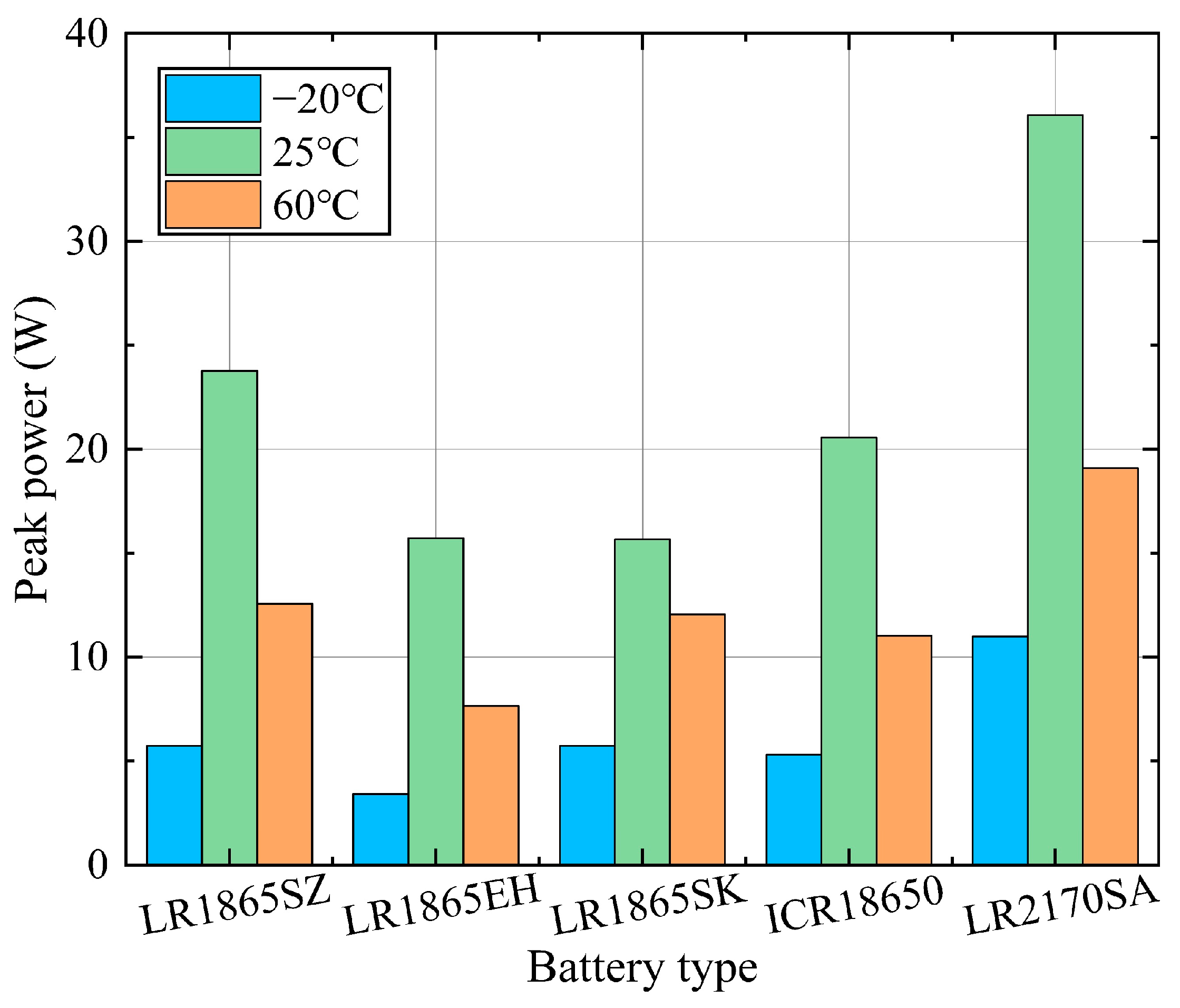
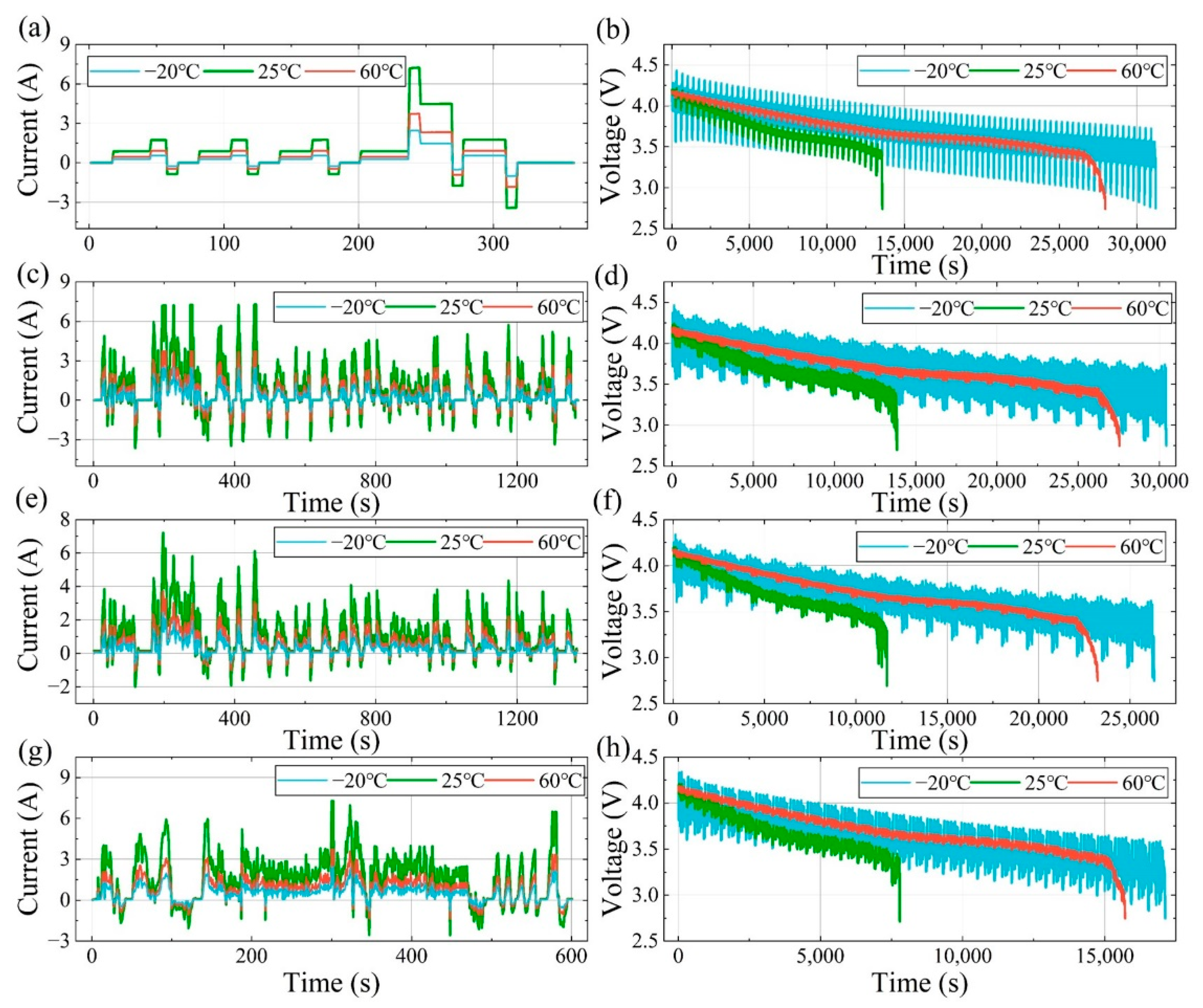
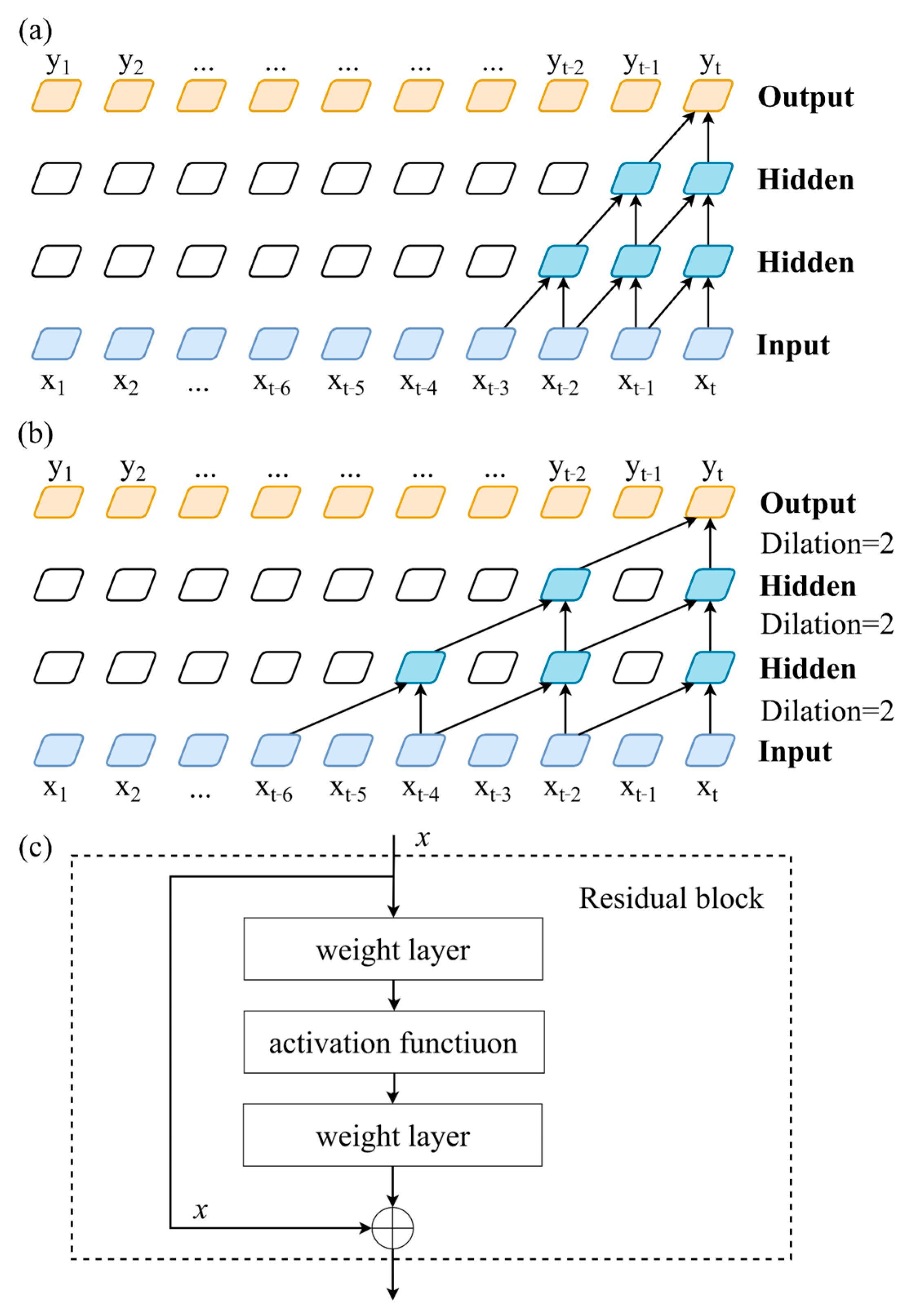
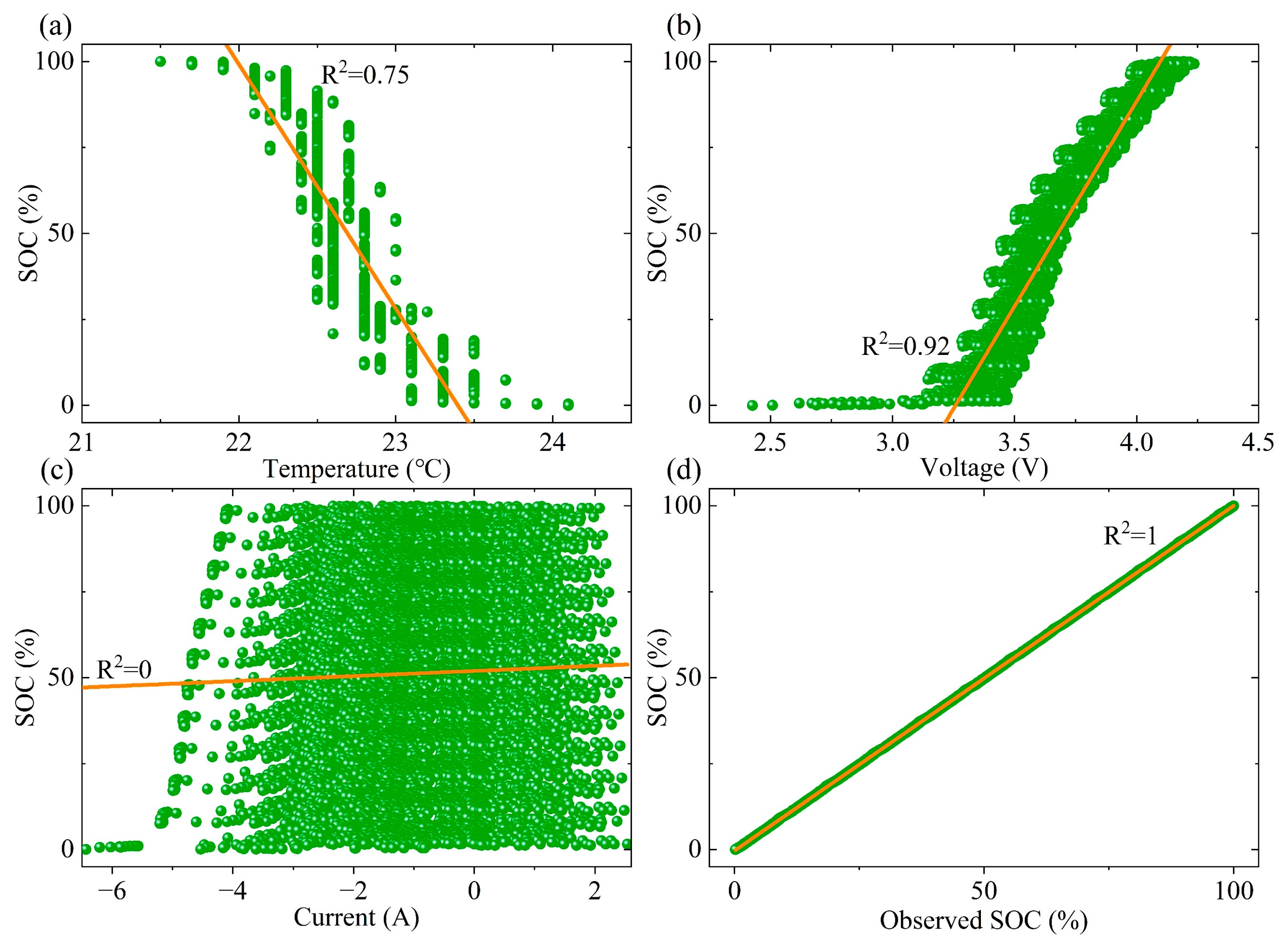
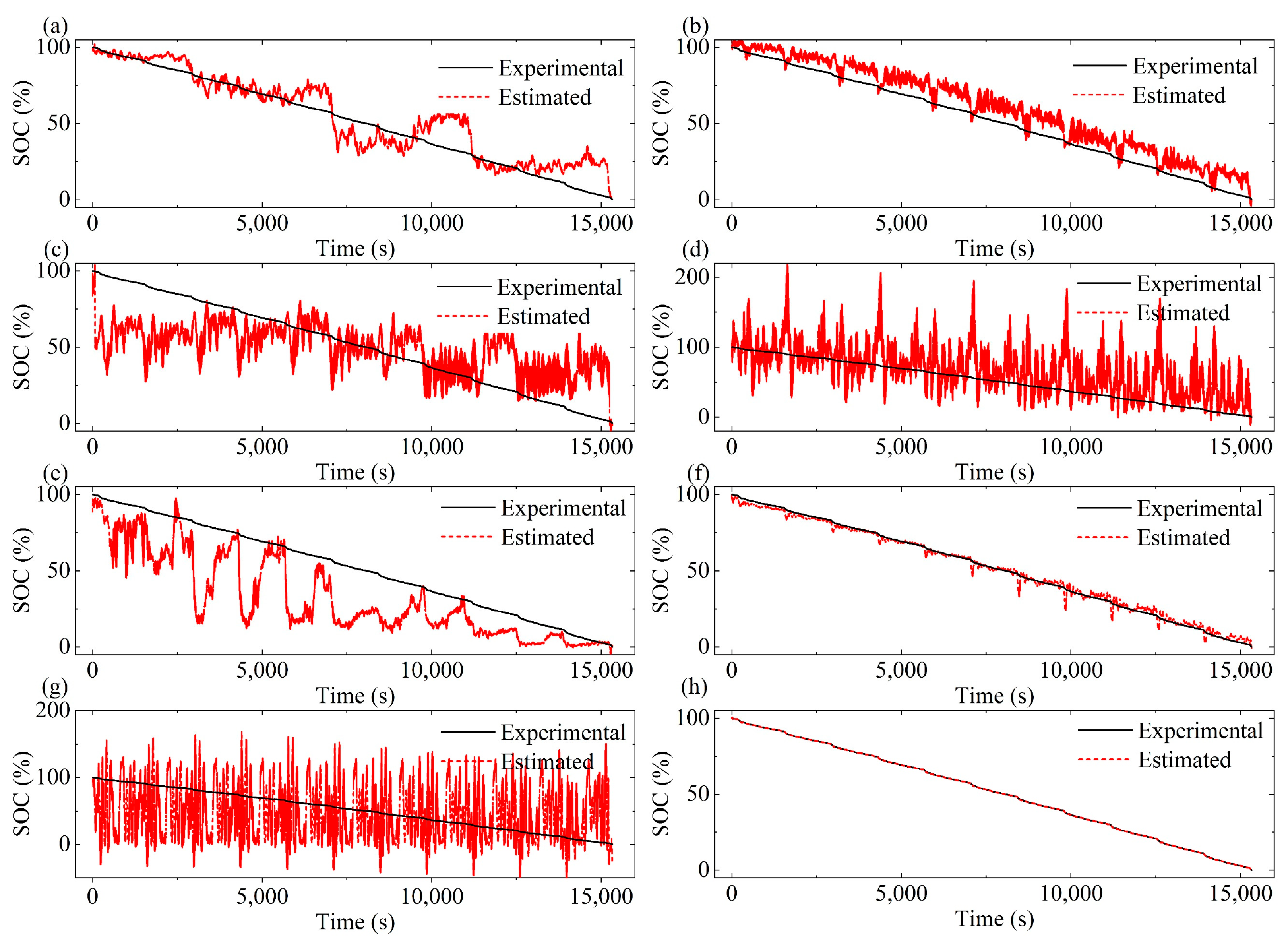
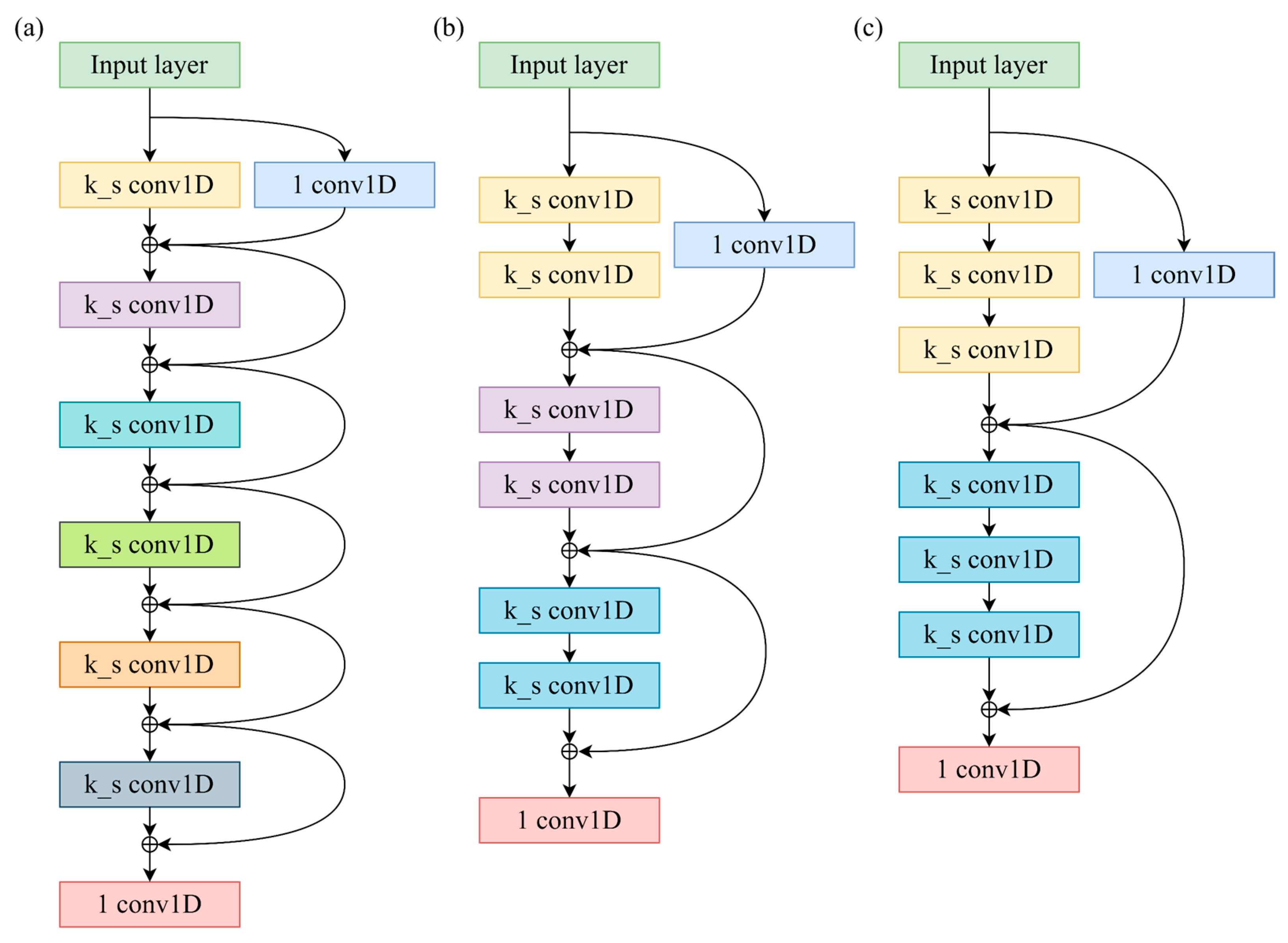
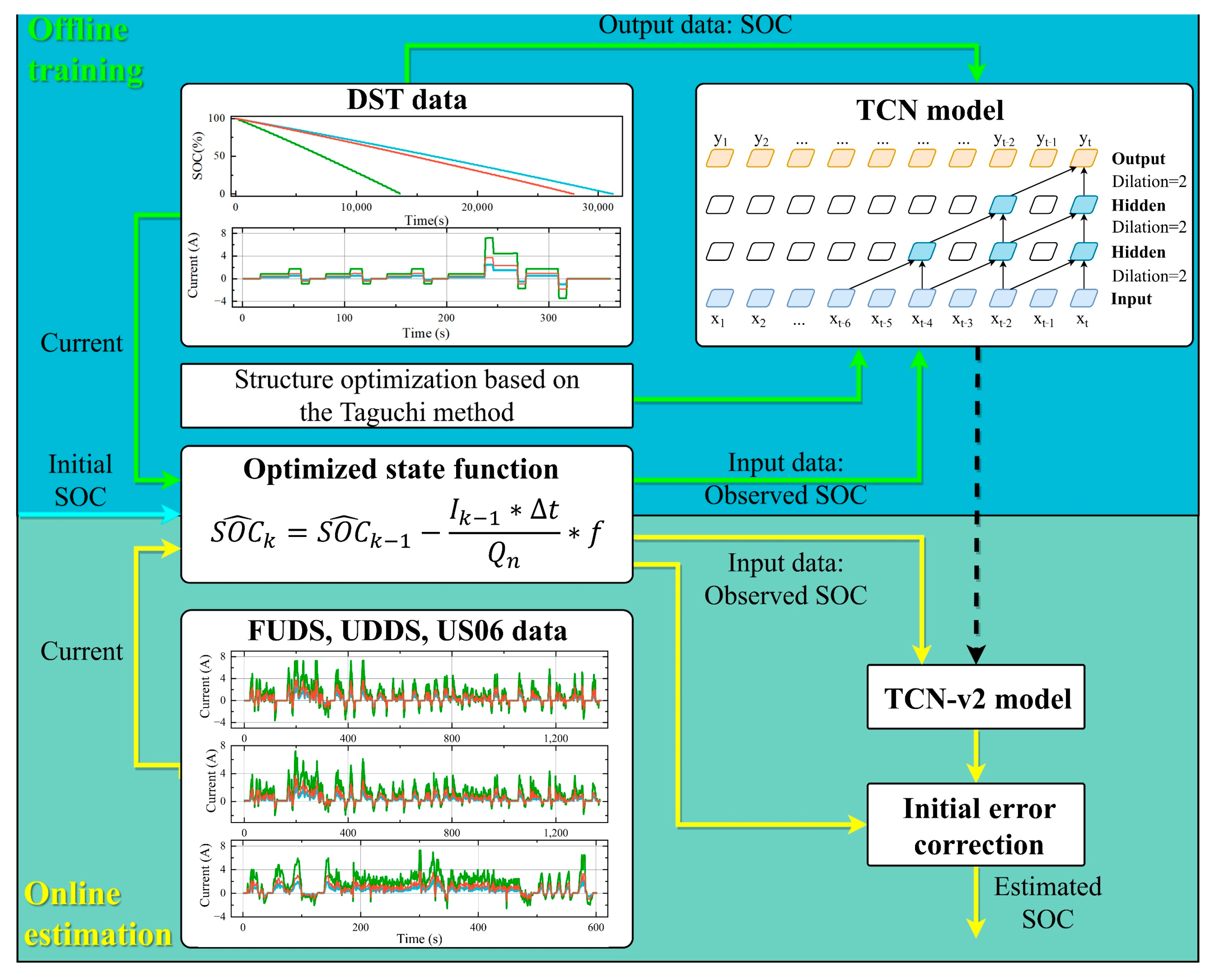
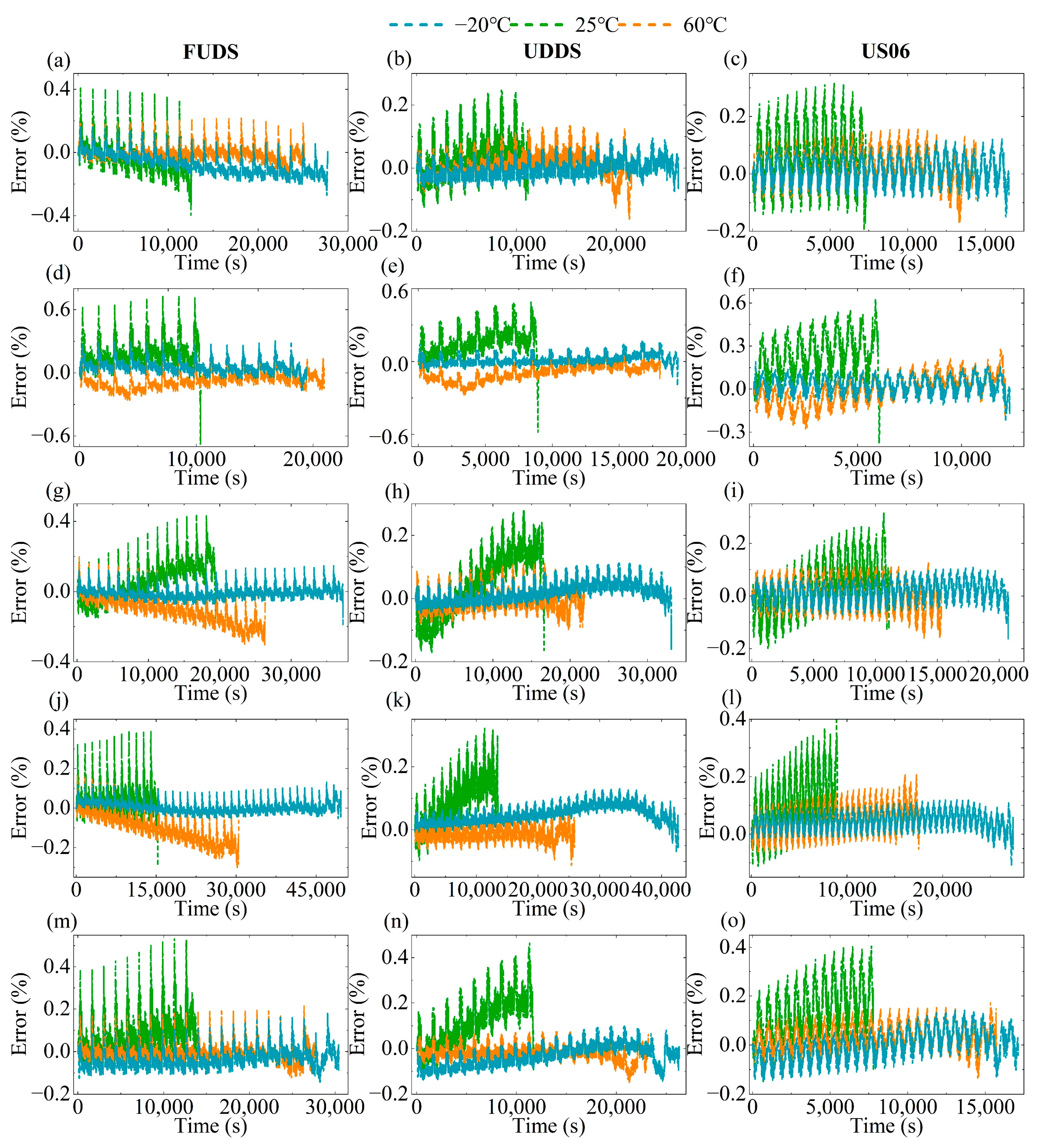
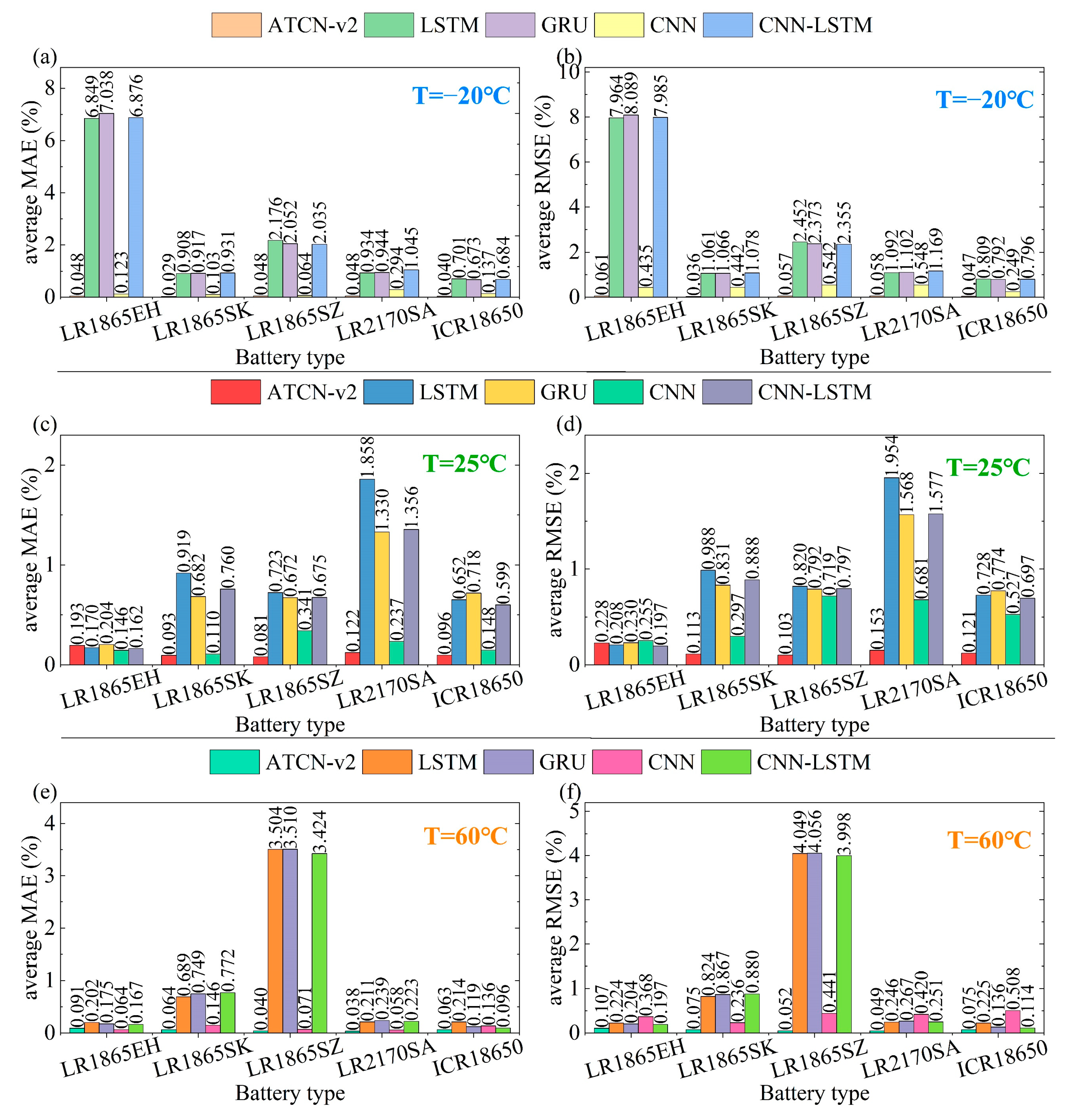
| Battery Types | Electrode Material | Nominal Capacity (Ah) | Cut-off Voltage (V) | Charging Voltage (V) | Recommended Operating Temperatures |
|---|---|---|---|---|---|
| LR1865EH | LiFePO4/ graphite | 1.7 | 2.0 | 3.6 | 0~45 °C (charge); −20~60 °C (discharge) |
| LR1865SK | LiFePO4/ graphite | 2.6 | 2.75 | 4.2 | |
| LR1865SZ | LiFePO4/ graphite | 2.5 | 3.0 | 4.2 | |
| LR2170SA | Li(Ni0.5Co0.2 Mn0.3)O2/ graphite | 4.0 | 2.75 | 4.2 | |
| ICR18650 | LiCoO2/ graphite | 2.55 | 2.5 | 4.2 |
| Neural Networks | FUDS | UDDS | US06 | |||
|---|---|---|---|---|---|---|
| MAE (%) | RMSE (%) | MAE (%) | RMSE (%) | MAE (%) | RMSE (%) | |
| TCN-v1 | 0.059 | 0.102 | 0.089 | 0.122 | 0.116 | 0.159 |
| TCN-v2 | 0.062 | 0.091 | 0.099 | 0.119 | 0.128 | 0.157 |
| TCN-v3 | 0.062 | 0.102 | 0.099 | 0.128 | 0.129 | 0.167 |
| Temperature | Cases | FUDS | UDDS | US06 | |||
|---|---|---|---|---|---|---|---|
| MAE (%) | RMSE (%) | MAE (%) | RMSE (%) | MAE (%) | RMSE (%) | ||
| −20 °C | LR1865EH | 0.060 | 0.080 | 0.028 | 0.038 | 0.055 | 0.066 |
| LR1865SK | 0.027 | 0.034 | 0.026 | 0.033 | 0.034 | 0.041 | |
| LR1865SZ | 0.083 | 0.097 | 0.021 | 0.026 | 0.041 | 0.048 | |
| LR2170SA | 0.049 | 0.056 | 0.047 | 0.058 | 0.049 | 0.060 | |
| ICR18650 | 0.022 | 0.029 | 0.050 | 0.056 | 0.047 | 0.055 | |
| 25 °C | LR1865EH | 0.185 | 0.226 | 0.156 | 0.182 | 0.237 | 0.277 |
| LR1865SK | 0.099 | 0.123 | 0.094 | 0.109 | 0.086 | 0.107 | |
| LR1865SZ | 0.088 | 0.113 | 0.048 | 0.064 | 0.107 | 0.132 | |
| LR2170SA | 0.094 | 0.128 | 0.127 | 0.154 | 0.145 | 0.177 | |
| ICR18650 | 0.061 | 0.090 | 0.099 | 0.118 | 0.127 | 0.156 | |
| 60 °C | LR1865EH | 0.092 | 0.105 | 0.097 | 0.114 | 0.083 | 0.103 |
| LR1865SK | 0.114 | 0.132 | 0.028 | 0.034 | 0.049 | 0.058 | |
| LR1865SZ | 0.036 | 0.051 | 0.031 | 0.040 | 0.052 | 0.064 | |
| LR2170SA | 0.034 | 0.047 | 0.029 | 0.037 | 0.051 | 0.063 | |
| ICR18650 | 0.106 | 0.123 | 0.024 | 0.029 | 0.059 | 0.073 | |
| Algorithm | Average MAE (%) | Average RMSE (%) |
|---|---|---|
| ATCN-v2 | 0.073 | 0.089 |
| LSTM | 1.381 | 1.576 |
| GRU | 1.335 | 1.543 |
| CNN | 0.145 | 0.444 |
| CNN-LSTM | 1.320 | 1.532 |
| Parameter | Algorithm | The SD of MAE (%) | The SD of RMSE (%) |
|---|---|---|---|
| Temperature | ATCN-v2 | 0.037 | 0.044 |
| LSTM | 1.245 | 1.430 | |
| GRU | 1.237 | 1.427 | |
| CNN | 0.064 | 0.102 | |
| CNN-LSTM | 1.215 | 1.413 | |
| Driving cycle | ATCN-v2 | 0.018 | 0.019 |
| LSTM | 0.548 | 0.630 | |
| GRU | 0.543 | 0.627 | |
| CNN | 0.022 | 0.048 | |
| CNN-LSTM | 0.535 | 0.622 | |
| Battery type | ATCN-v2 | 0.027 | 0.031 |
| LSTM | 1.433 | 1.640 | |
| GRU | 1.407 | 1.620 | |
| CNN | 0.068 | 0.131 |
| Algorithms | −20 °C | 25 °C | 60 °C | |||
|---|---|---|---|---|---|---|
| The SD of MAE (%) | The SD of RMSE (%) | The SD of MAE (%) | The SD of RMSE (%) | The SD of MAE (%) | The SD of RMSE (%) | |
| ATCN-v2 | 0.092 | 0.105 | 0.097 | 0.114 | 0.083 | 0.103 |
| LSTM | 0.114 | 0.132 | 0.028 | 0.034 | 0.049 | 0.058 |
| GRU | 0.036 | 0.051 | 0.031 | 0.040 | 0.052 | 0.064 |
| CNN | 0.034 | 0.047 | 0.029 | 0.037 | 0.051 | 0.063 |
| CNN-LSTM | 0.106 | 0.123 | 0.024 | 0.029 | 0.059 | 0.073 |
Publisher’s Note: MDPI stays neutral with regard to jurisdictional claims in published maps and institutional affiliations. |
© 2022 by the authors. Licensee MDPI, Basel, Switzerland. This article is an open access article distributed under the terms and conditions of the Creative Commons Attribution (CC BY) license (https://creativecommons.org/licenses/by/4.0/).
Share and Cite
Miao, J.; Tong, Z.; Tong, S.; Zhang, J.; Mao, J. State of Charge Estimation of Lithium-Ion Battery for Electric Vehicles under Extreme Operating Temperatures Based on an Adaptive Temporal Convolutional Network. Batteries 2022, 8, 145. https://doi.org/10.3390/batteries8100145
Miao J, Tong Z, Tong S, Zhang J, Mao J. State of Charge Estimation of Lithium-Ion Battery for Electric Vehicles under Extreme Operating Temperatures Based on an Adaptive Temporal Convolutional Network. Batteries. 2022; 8(10):145. https://doi.org/10.3390/batteries8100145
Chicago/Turabian StyleMiao, Jiazhi, Zheming Tong, Shuiguang Tong, Jun Zhang, and Jiale Mao. 2022. "State of Charge Estimation of Lithium-Ion Battery for Electric Vehicles under Extreme Operating Temperatures Based on an Adaptive Temporal Convolutional Network" Batteries 8, no. 10: 145. https://doi.org/10.3390/batteries8100145
APA StyleMiao, J., Tong, Z., Tong, S., Zhang, J., & Mao, J. (2022). State of Charge Estimation of Lithium-Ion Battery for Electric Vehicles under Extreme Operating Temperatures Based on an Adaptive Temporal Convolutional Network. Batteries, 8(10), 145. https://doi.org/10.3390/batteries8100145







